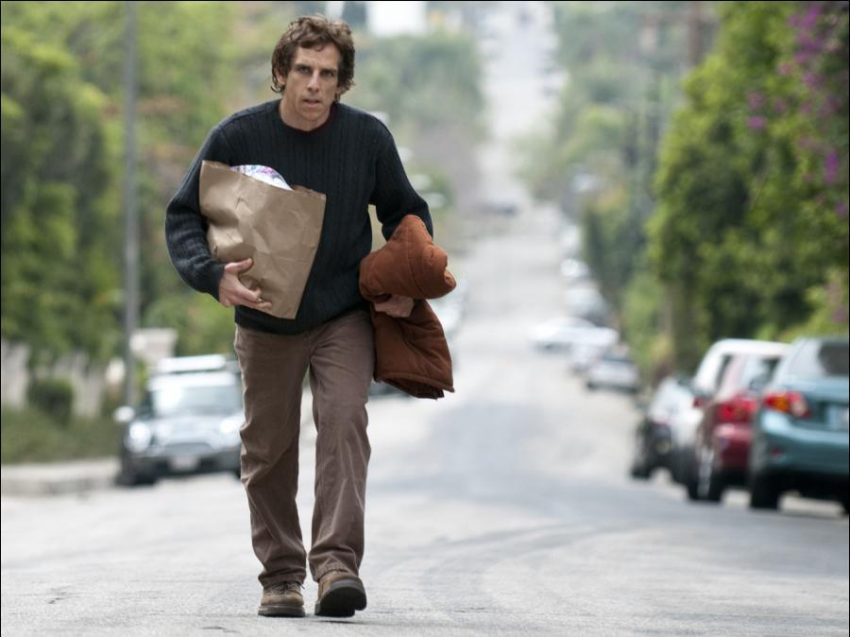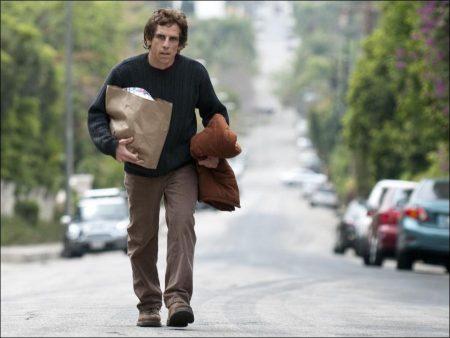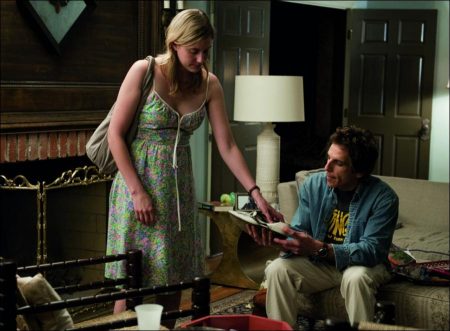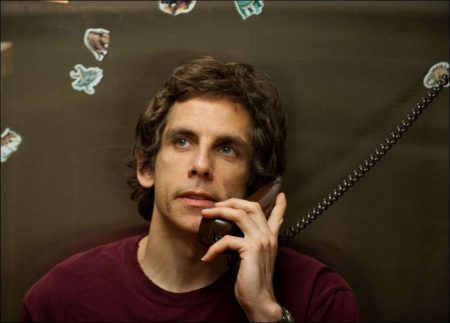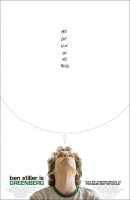Taglines: He got a lot on his mind.
Meet Roger Greenberg (Ben Stiller): a dysfunctional 40-year-old at a crossroads in his life. Roger wants to “do nothing” for a while, so he agrees to housesit for his younger and more successful brother, giving him a free place to stay in L.A. While in town, he tries to reconnect with his old friends and band mates but times have changed, and old friends aren’t necessarily still best friends. Greenberg starts spending time with his brother’s personal assistant Florence (Great Gerwig), an aspiring singer and herself something of a lost soul too.
During a series of embarrassingly awkward romantic encounters, we sense that perhaps even someone as irascible as Greenberg may have found somebody who is prepared to appreciate him for himself – if he would only stop critiquing Florence’s techniques in bed. Over the course of several weeks, we watch an uncertain and wonderfully vulnerable courtship play out, and learn how funny, and terribly unpredictable, love in the modern world can be.
Writer / director Noah Baumbach and producer / actor Jennifer Jason Leigh had previously teamed with Academy Award-winning producer Scott Rudin on Margot at the Wedding. Even as the film was being completed and then released in 2007 – to accolades including an Independent Spirit Award nomination for Ms. Leigh – the trio was already planning a new picture together.
Baumbach and Leigh mapped out the new movie as one that would afford Baumbach the opportunity to once again interlace emotional insight with biting wit, as he had in pictures from his debut Kicking and Screaming to the Oscar-nominated The Squid and the Whale.
Baumbach and Leigh conceived a story that would take the writer/director to Los Angeles for filming. Several years prior, Leigh had co-written and co-directed a Los Angeles-set tale of relationships, The Anniversary Party. But Greenberg would make even more use of the city, as much more than a backdrop for the splendidly realized characters in the screenplay.
It would be filmed on a tight seven-week schedule, roughly the same amount of time the title character, Roger Greenberg, finds himself in Los Angeles. “Los Angeles plays such a big part in Greenberg that it’s another character, adding to the vibe of the film, says locations manager Stephenson Crossley. “I didn’t have to show Noah a lot of photos to give him different options. For the most part, he knew where he wanted to go and a lot of those places were written into the script – so it was my job to get us in there.
“Many of the locations very specifically noted in the script hadn’t been featured in movies before, or at least weren’t instantly recognizable. But we weren’t a big-budget film, and since there’s no gunfire or special effects in the picture, it’s less disruptive to a place or a community. So, people were pretty accommodating.
For example, the famed Musso & Frank Grill on Hollywood Boulevard, first opened in 1919 and a local institution ever since, was scripted as the setting for a modest yet arguably (to Greenberg, at least) excessive birthday celebration.
While other movies had shot there over the years, “we got them to close on a Tuesday for the first time in their history, says Crossley. “We expressed to the owner how important it was for us to shoot there, and how it would help bring the film and the characters to life. The mandate from Noah was always real places and real people. Accordingly, the restaurant’s real-life waiters, one a 50-year veteran, were on duty for the sequence – and regular customers came in to be extras.
Other L.A. locations were also specifically written into the script for verisimilitude. These included Lucy’s El Adobe restaurant, across the street from Paramount Pictures; the Runyon Canyon hiking trails, 160 acres of the Santa Monica Mountains that are a sanctuary for dog walkers; the Fairfax district, where orthodox Jews are seen walking to and from Temple every Friday and Saturday, alongside the trendsetters who hit the restaurants and boutiques along Melrose Avenue; and the Highland Gardens Hotel.
Most of the locations were in Hollywood or West Hollywood – accurately representing what would be within walking distance for the non-driving Greenberg – including a veterinarian’s office where Leigh and Baumbach have taken their own pets.
The Silverlake area art gallery Machine Project allowed the production to incorporate an existing art installation into filming. Crossley explains, “The artists were building a forest in that space – and we had one night to shoot there before that exhibition opened.
“Our production designer, Ford Wheeler, worked with me at all times, mapping out what he was designing in tandem with where we would be shooting. Hopefully Greenberg will give audiences a sense of what it’s actually like to live – or visit – here.
Cinematographer Harris Savides captured Los Angeles for Greenberg in widescreen, reteaming with the filmmakers after their work on Margot at the Wedding. This made the new movie at once more cinematic and more real – almost documentary-like, given the extensive location shooting.
Following the lensing all around town, the latter half of the shoot took place in and around a 1920s-era house in the Hollywood Hills which was cast as the Greenberg home.
Wheeler and his team transformed the house to reflect both the established world of Philip’s family and the transient nature of Greenberg’s existence in their absence. Recommended by a colleague to Wheeler, set decorator Elizabeth Keenan immediately began working closely with him and the filmmakers.
She notes, “Getting the house together entailed seven-day weeks for about a month, from paint color tests with Harris filming to playing with white spaces. But on this shoot, there was a wonderful camaraderie.
“Noah and Jennifer were so specific about what they wanted to show and who these characters were. They had been thinking about the people in this story for a long time – which actually made things easier. Working with them was a process of getting to know the characters and pushing the story ahead; for me, being responsible for everything that isn’t a floor or a wall, the set decoration on Greenberg extended to bedside reading, chosen perfumes, and – with the costume department – what clothes a character would have in his or her closet.
If clothes do make the man, then, as costume designer Mark Bridges notes, “There’s an element of Greenberg that lives a bit in the past and hasn’t really moved on from a certain time. You see how he’s more strongly attached to it than his friend Ivan is. He still feels as if he’s starting out, but time is going by. He has kind of a late ’80s/early ’90s look, in colors that you don’t see so much these days any more – like his caramel cotton sweater. The idea was to subtly evoke a feeling of an earlier time without broadcasting it. Even his shoes were important to me; you may never see them on camera, but I work from the ground up.
“In terms of the L.A. experience, we wanted you to relate to Greenberg’s discomfort when, say, he’s at Musso & Frank or at the afternoon barbecue [filmed at a Los Feliz house] – and especially for the big party sequence, where some of the kids are riffing on the ’80s in their fashion choices, which makes things more surreal for him then they already are. If you don’t notice these things, then I’ve done my job, because it’s up to Noah and Harris to guide viewers to what they’re supposed to see.
Elaborating on how much he prizes the collaborative nature of making movies, Bridges offers, “After reading the script, I already see the movie in my mind’s eye. Then, working with the director, we compare points of view and reassess after a role is cast. I feel fortunate that I’m able to help the actor create his role.
To bring the lead character to life, the filmmakers tapped Ben Stiller. The actor says, “I was a fan of The Squid and the Whale – the reality, the tone, and the emotion of it – and Margot at the Wedding and Kicking and Screaming. Noah finds humor without going for laughs.
“So I was very excited to get this script and then get to talk to him about it. When we got into the process of working on the movie, I knew I was with a filmmaker who had a really clear vision of what he wanted to do and a point of view – yet was also open to what’s going on in the moment.
Known as being skilled in improvisation and therefore able to elevate a scene, Stiller found that “Noah’s work is very detailed and goes into specifics on the characters; it’s all written on the page. We rehearsed a lot; it really has to be said as written. So there was hardly any improvisation on the shoot and that was exciting – not having the burden of having to come up with something to try to make it better. What I had to do was to make sure that I would get the rhythm of his dialogue, his lines, to work. Some sequences – 4-6 pages in the script – were like doing little plays.
“In this movie, you see the incremental building of a relationship between two people who – like everybody – have issues in their lives. Greenberg and Florence are able to come together and get past self-imposed barriers. Until now, I’d never done a film which reminded me of the Hal Ashby or Robert Altman movies of the 1970s that would explore characters and find their little private moments that happen and that you don’t usually see in movies.
These moments are captured, marvels Stiller, “with no video playback on the set for Noah to look at. We would do a lot of takes of a scene, with Noah making adjustments; ‘You want to get out of that room quicker,’ or ‘You really feel let down by this guy.’ He wants to get at the reality of the people.
Greenberg )2010)
Directed by: Noah Baumbach
Starring: Ben Stiller, Greta Gerwig, Rhys Ifans, Mark Duplass, Brie Larson, Juno Temple, Jennifer Jason Leigh, Merritt Wever, Susan Traylor, Aaron Wrinkle, Heather Lockie, Zach Chassler, Mina Badie
Screenplay by: Noah Baumbach
Production Design by: Ford Wheeler
Cinematography by: Harris Savides
Film Editing by: Tim Streeto
Costume Design by: Mark Bridges
Set Decoration by: Elizabeth Keenan
Art Direction by: Curt Beech
Music by: James Murphy
MPAA Rating: R for some strong sexuality, drug use, and language.
Studio: Focus Features
Release Date: March 12, 2010
